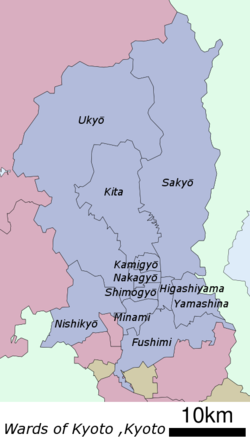
The city of Kyoto in Kyoto Prefecture, Japan has eleven wards.
| Name | Japanese | Established | Code [1] |
|---|---|---|---|
| Fushimi-ku | 伏見区 | 1931 (by merger of surrounding municipalities) | 261092 |
| Higashiyama-ku | 東山区 | 1921 (divided from Kamigyō) | 261050 |
| Kamigyō-ku | 上京区 | 1879 (one of original two wards) | 261025 |
| Kita-ku | 北区 | 1955 (divided from Kamigyō) | 261017 |
| Minami-ku | 南区 | 1955 (divided from Shimogyō) | 261076 |
| Nakagyō-ku | 中京区 | 1929 (divided from Kamigyō and Shimogyō) | 261041 |
| Nishikyō-ku | 西京区 | 1976 (divided from Ukyō) | 261114 |
| Sakyō-ku | 左京区 | 1929 (divided from Kamigyō) | 261033 |
| Shimogyō-ku | 下京区 | 1879 (one of original two wards) | 261068 |
| Ukyō-ku | 右京区 | 1931 (by merger of surrounding municipalities) | 261084 |
| Yamashina-ku | 山科区 | 1976 (divided from Higashiyama) | 261106 |
Unlike the 23 special wards of Tokyo, the wards of Kyoto are not separate municipalities, they are divisions just for municipal administration. Together, they comprise the city of Kyoto, under a single mayor and city council.
| Name | Population | Density (/km2) | Area (km2) | % of total | Forest Area (km2) | Forest Cover | Inhabitable Area | |
|---|---|---|---|---|---|---|---|---|
| (km2) | Density (/km2) | |||||||
| Fushimi-ku | 280,655 | 4,552 | 61.66 | 7.4% | 14.58 | 23.6% | 47.12 | 5,956 |
| Higashiyama-ku | 39,044 | 5,220 | 7.48 | 0.9% | 1.58 | 21.1% | 5.90 | 6,618 |
| Kamigyō-ku | 85,113 | 12,107 | 7.03 | 0.8% | 0.00 | 0.0% | 7.03 | 12,107 |
| Kita-ku | 119,474 | 1,259 | 94.88 | 11.5% | 78.85 | 83.1% | 16.02 | 7,458 |
| Minami-ku | 99,927 | 6,320 | 15.81 | 1.9% | 0.00 | 0.0% | 15.81 | 6,320 |
| Nakagyō-ku | 109,341 | 14,756 | 7.41 | 0.9% | 0.00 | 0.0% | 7.41 | 14,756 |
| Nishikyō-ku | 150,962 | 2,548 | 59.24 | 7.2% | 32.53 | 54.9% | 26.82 | 5,629 |
| Sakyō-ku | 168,266 | 682 | 246.77 | 29.8% | 215.26 | 87.2% | 31.55 | 5,333 |
| Shimogyō-ku | 82,668 | 12,193 | 6.78 | 0.8% | 0.00 | 0.0% | 6.78 | 12,193 |
| Ukyō-ku | 204,262 | 699 | 292.07 | 35.3% | 253.77 | 86.9% | 38.29 | 5,335 |
| Yamashina-ku | 135,471 | 4,720 | 28.70 | 3.5% | 13.64 | 47.5% | 15.40 | 8,797 |
| Total | 1,475,183 | 1,782 | 827.83 | 100.0% | 610.21 | 73.7% | 218.13 | 6,763 |